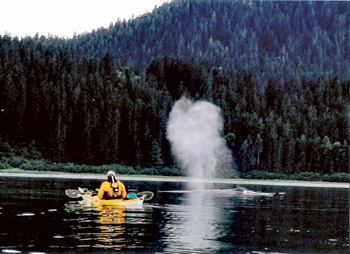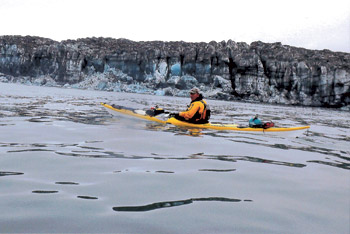The soft glow of the midnight sun hung below the horizon and the sea began swelling into heavy, white waves. After paddling on the open water for 13 hours, Fred de Lepper and Brett Burglund were ready to peel out of their kayaks and set up camp next to a fire on the remote Alaskan coastline.
But Lost Coast was growing rowdy.
The two kayakers from Kalispell had spent weeks paddling 320 miles along the inner seashore as a de facto warm-up to Lost Coast, an infamous and unforgiving stretch of water with a reputation as one of the most ravenous on the planet. It’s a vast section of exposed ocean coast that’s riddled with ill-tempered weather and far away from help. Fishing boats stay away and it’s rare that paddlers are successful in their expedition.
When de Lepper and Burglund arrived at the site where they planned to go ashore, they discovered an unexpected landscape. Explosive offshore waves had erupted and transformed the inlet instantly, making their map useless. The ocean repeatedly ripped open breakers that would easily devour their boats, guarding the only lagoon in sight.
A knot clenched in de Lepper’s stomach as he thought, “We might be spending the night in our kayaks.”
In early June, the two longtime friends journeyed from Kalispell to the southeast section of Alaska to explore “The Last Frontier” in sea kayaks.
They hoped to travel nearly 700 miles across untamed ocean in the Gulf of Alaska. It was a wild, dangerous dream they both shared.
Raised in the flat country of the Netherlands, de Lepper has always felt a magnetism toward wild mountains and waters. He moved to Montana in 1987 and became close friends with Burglund’s family.
Over the years his passion for adventuring outgrew his local range, so he ventured north.
“The American West and the Canadian West has always inspired me as a place where you can still get lost and have real adventure,” says de Lepper, 50, who has traveled Alaska by sea five times in his life.
“To me, it’s the inspiration to go. It’s not about setting any records. It’s about seeing some real wild places. Therefore you see amazing things. It’s so exciting, you can’t even begin to explain what that is like.”
Vast glacial mountains sit on the edge of the continent in the rugged labyrinth of Alaskan coastline. The biggest non-polar ice fields in the world reside there. The marine wilderness of Glacier Bay National Park provides glimpses of the ice age through a mosaic of backcountry wilderness and wildlife.
As visitors often say, it’s Montana on steroids.
 |
|
Burglund and de Lepper experienced many wildlife sightings during their 661-mile paddle, including several run-ins with whales off the coastline of southeastern Alaska. One of the highlights of the trip, de Lepper said, was seeing the wild animals living untamed in the great outdoors of Alaska. – Courtesy photo |
From the seat of a kayak, de Lepper has watched grizzly bears running up and down the beach; fleets of 50-foot-long humpback whales breaching the ocean surface and thundering back into the water; and flocks of birds, thousands at a time, filling the sky.
“It’s one of those places where all of your senses come alive,” de Lepper says. “You’re walking around that country and it makes the hair on the back of your neck stand up.”
Ever since Burglund was a kid growing up in the Flathead Valley, learning how to kayak from de Lepper on the forks of the Flathead River, he had heard tales of epic adventures in Alaska.
The descriptions stuck in his mind over the years as the 2003 Flathead High graduate developed into a talented paddler, often placing in the Wild Mile race during Bigfork’s Whitewater Festival.
But Burglund was forced to decline several offers from de Lepper to join him in Alaska, until finally the timing was right. In May, the 28-year-old graduated from Montana State University. A few weeks later he returned home to Kalispell and met up with de Lepper.
They launched into the ocean from Wrangell, Alaska, on June 17. Together they would traverse the isolated coastline that’s longer than all other American coastlines combined.
By 2 a.m., de Lepper and Burglund were going on 18 hours and nearly 50 miles of paddling. They pushed forward, exhausted and nearly delirious. They attempted to keep a close eye on the shoreline, staying far enough away so as not to get sucked into the rocky cliffs. They kept a light aimed at their compasses and stuffed their life jackets with energy bars.
The sunlight faded as they paddled along a devious route in search of a safe inlet. For a few hours, the silhouette of Mount Saint Elias was all they could see.
“You didn’t know when the sea stopped and the sky began. It melted into one,” Burglund says. “You’d look over and get vertigo almost, like you’re skiing in the fog on Big Mountain. You’d have to stay looking at the boat. We could always hear the waves crashing. It was the most surreal dreamlike paddling I’ve ever experienced.”
At 3:30 a.m., they approached an area near Yakutat, a community near the coast, but strong head winds hit, slowing progress. De Lepper turned on his satellite radio to see if any fishing boats were in the area in case conditions continued to worsen.
Silence.
By 4:30 a.m., conditions worsened into stormy weather and waves. The sun rose again, and the men took turns leading, staying mostly silent.
By 7 a.m., they could hardly paddle and faced the reality they could push no further and needed to land. De Lepper led, forging through 10-foot waves.
“At this point I had visions of broken bodies and gear on the beach,” he says.
 |
|
Along with wildlife sightings, de Lepper and Burglund encountered the awe-inspiring geography of Alaska, including glacial coastline. – Courtesy photo |
But by this point they had learned a few lessons in previous surf landings and managed to maneuver their boats through a minefield of breakers. They landed safely on the beach, euphoric, delirious and thoroughly shaken.
All told, they paddled 70 miles in 24 consecutive hours.
“There was no real time where I felt scared for my life or anything, or so exhausted that I would end up swimming. There was a big feeling of accomplishment that I never, never want to do again, but just at the same time it was awesome,” Burglund says.
“That trip, I would’ve never chosen another partner to do it with. Fred was perfect.”
That night, like they did nearly every night during their 30-day, 661-mile odyssey, they feasted on fresh salmon by the campfire.
Even weeks after returning home safely, they could still feel the euphoria and delight of the experience.
“When I read my diary of past trips, I’ve written about what I’m looking for no longer exists,” de Lepper says.
“To be able to still find a place that has so much intact, it inspires me. I want to go back.”